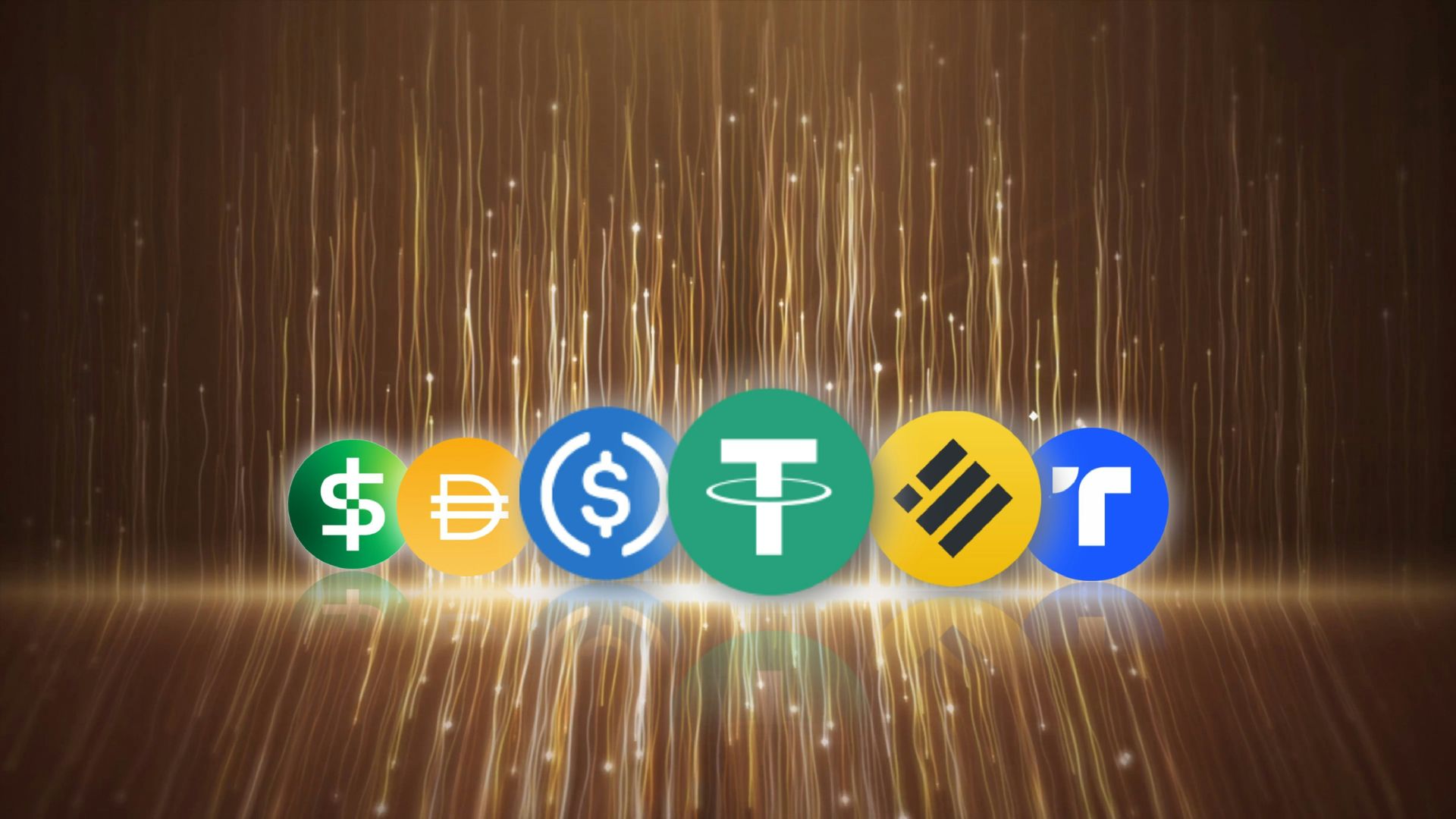The cryptocurrency market is notorious for its wild price swings, leaving many investors yearning for a haven from the storm. Enter stablecoins – a unique breed of cryptocurrency designed to offer price stability, bridging the gap between the traditional financial world and the exciting but often unpredictable realm of digital assets. In this article, we’ll take a look at stablecoins meaning, types of stablecoins, differences from other coins, and other pertinent details that would let you engage in trading stablecoins with more confidence.
Stablecoins explained: What are stablecoins?
Stablecoins are cryptocurrencies that aim to maintain a stable value relative to a specific asset or basket of assets. This underlying asset could be a fiat currency like the US dollar, a commodity like gold, or even another cryptocurrency. The goal is to mitigate the volatility inherent in most cryptocurrencies, making stablecoins suitable for everyday transactions, storing value, and hedging against market fluctuations.
What are two types of stablecoins?
While numerous stablecoin models exist, they generally fall into two primary categories:
- Fiat-Collateralized Stablecoins: These stablecoins maintain their peg to a fiat currency by holding reserves of that currency in a 1:1 ratio. For example, for every Tether (USDT) issued, there should be one US dollar held in reserve.
- Crypto-Collateralized Stablecoins: These stablecoins are backed by reserves of other cryptocurrencies. However, since the underlying crypto collateral is inherently volatile, these stablecoins often employ over-collateralization and complex algorithms to maintain their peg. MakerDAO’s DAI is a prime example of a crypto-collateralized stablecoin.
Stablecoins list
Here’s a glimpse at some of the most popular stablecoins in the market:
- Tether (USDT): Pegged to the US dollar, Tether is currently the largest stablecoin by market capitalization.
- USD Coin (USDC): Another popular US dollar-pegged stablecoin known for its transparency and regulatory compliance.
- Binance USD (BUSD): Issued by Binance, BUSD is a regulated stablecoin pegged to the US dollar.
- DAI (DAI): A decentralized, crypto-collateralized stablecoin governed by the MakerDAO protocol.

What is Bitcoin stablecoins? Are they any different from other stablecoins?
Bitcoin stablecoins are a type of stablecoin that is pegged to the value of Bitcoin rather than a fiat currency like the US dollar. They are indeed different from other stablecoins in several key ways, including:
- Peg: While most stablecoins are pegged to fiat currencies (usually the US dollar), Bitcoin stablecoins are pegged to the value of Bitcoin.
- Purpose: The main purpose of Bitcoin stablecoins is to provide a way for Bitcoin holders to hedge against Bitcoin’s volatility without leaving the Bitcoin ecosystem.
- Collateral: Bitcoin stablecoins are typically backed by Bitcoin itself, whereas other stablecoins might be backed by fiat currencies, other cryptocurrencies, or assets like gold.
- Volatility: Because they’re pegged to Bitcoin, these stablecoins are still subject to Bitcoin’s overall market volatility when compared to fiat currencies. They’re “stable” in terms of Bitcoin value, not necessarily in terms of fiat value.
- Use case: They’re often used within Bitcoin-focused decentralized finance (DeFi) ecosystems, allowing users to trade or lend without converting their Bitcoin to other assets.
Some examples of Bitcoin stablecoins include:
- tBTC (wrapped Bitcoin on Ethereum)
- sBTC (synthetic Bitcoin)
- WBTC (Wrapped Bitcoin)
 It’s worth noting that while these are sometimes called “stablecoins,” they don’t provide the same kind of stability against fiat currencies that traditional stablecoins do. They’re more accurately described as tokenized representations of Bitcoin on other blockchain networks.
It’s worth noting that while these are sometimes called “stablecoins,” they don’t provide the same kind of stability against fiat currencies that traditional stablecoins do. They’re more accurately described as tokenized representations of Bitcoin on other blockchain networks.
Trading stablecoins
Trading stablecoins refers to the buying, selling, or exchanging of stablecoins – cryptocurrencies designed to maintain a stable value relative to a specific asset, typically the US dollar. Unlike trading volatile cryptocurrencies like Bitcoin or Ethereum, stablecoin trading often focuses on arbitrage opportunities, yield farming, or using them as a temporary store of value.
Trading & storing stablecoins
Stablecoins can be bought, sold, or traded on most major cryptocurrency exchanges, including:
- Centralized exchanges: Binance, Coinbase, Kraken
- Decentralized exchanges: Uniswap, SushiSwap, PancakeSwap
- Over-the-counter (OTC) desks for large volume trades
Stablecoins can be stored in various types of cryptocurrency wallets:
- Hardware wallets (e.g., Ledger, Trezor) for maximum security
- Software wallets (e.g., MetaMask, Trust Wallet) for convenience
- Exchange wallets, though this is generally not recommended for long-term storage
Differences from trading other coins
Trading stablecoins differs from trading other cryptocurrencies in several ways:
- Lower volatility, which means smaller potential gains but also reduced risk
- Often used as a safe haven during market turbulence
- Frequently used in trading pairs and as an intermediary in crypto-to-crypto trades
Stablecoins as quote currency
Stablecoins are often used as the quote currency in trading pairs. A quote currency is the second currency listed in a currency pair, representing the amount of that currency needed to buy one unit of the base currency. For example, in the BTC/USDT pair, USDT (Tether) is the quote currency.
Using stablecoins as the quote currency allows traders to:
- Easily calculate the fiat value of their trades
- Reduce exposure to volatile cryptocurrencies
- Quickly move in and out of positions without converting to fiat
For traders looking for a place to trade their stablecoins, including against other coins, they might want to consider Bitsgap. Bitsgap is a crypto trading platform and aggregator that connects to more than 15 exchanges under one roof. It provides a host of other tools including automated trading bots and smart orders, making it easier for traders to manage their stablecoin and cryptocurrency trades across multiple platforms from a single interface.
A reliable store of value
Unlike their more volatile counterparts such as Bitcoin or Ethereum, stablecoins provide a reliable store of value and a predictable medium of exchange within the crypto space. This stability makes them particularly useful for traders looking to hedge against market fluctuations, as well as for those seeking to transfer value quickly and cheaply across borders. Stablecoins can be traded on a wide array of platforms, from major centralized exchanges like Binance and Coinbase to decentralized exchanges like Uniswap. For storage, users have multiple options ranging from secure hardware wallets for long-term holdings to convenient software wallets for more frequent transactions.
As the crypto market continues to evolve, stablecoins have found their niche as quote currencies in trading pairs, facilitating easier valuation and smoother transactions between different cryptocurrencies. Whether you’re a seasoned trader or a crypto novice, understanding and utilizing stablecoins can provide a valuable tool in navigating the often turbulent waters of the cryptocurrency market. With platforms like Bitsgap offering comprehensive trading solutions across multiple exchanges, managing your stablecoin portfolio and leveraging these unique digital assets has never been more accessible.
Featured image credit: Eray Eliaçık/Bing





